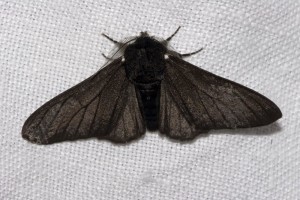“There’s absolutely no way we can justify the Cooper’s hawk as threatened or endangered because it has come back so strongly,” DeVito said. “They’ve changed their behavior. They learned how to live in the suburbs.” from Kirk Moore story in the Courier Post “Proposal for rules on wildlife causes stir”
Emile Devito’s quote hit a nerve in my addled brain – and illustrates fundamental problems.

white peppered moth
Thirty five years later, I still can recall a high school biology lesson on Darwinian evolution and natural selection – in this case, a vivid illustration of man induced adaptation. That lesson shocked me – both scientifically and ethically.
The phenomena we learned of was called “industrial melanism“. It was the case of the peppered moths of Manchester England. It was first noted in the 1800’s.
Moths and butterflies produce the most striking evidence of rapid evolutionary change, including induced responses from man’s alteration of the environment.
In Manchester, the white moth was dominant, while the black form of moth was rare in 1848. But 50 years later, black moths comprised more than 95% of all moths.
What happened?
Like the Cooper’s Hawk, it had “learned to live” with extreme pollution.

black variety – blends in with industrial air pollution
White moths stood out against the dark polluted industrial background soot that coated trees and other surfaces, while black moths blended right in. Predators had easy picking on the white ones.
So Darwinian “natural selection” favored the black moth.
But was this process natural? Are the implications ethical?
Cooper’s Hawk prime habitat is forested woodlands. NJ is losing that habitat to suburban development at an accelerating rate.
So, if Coooper’s Hawk now has adapted to suburban backyards (behaviorally, not genetically), does that justify eliminating forest habitat protections?
Under DEP regulations, threats to a species habitat are a legitimate factor in a threatened or endangered listing decision. Threats to habitat are as scientifically valid as population dynamics in deciding whether to list or delist a species. Specifically:
The reviewers consider data on species population and trends, productivity, survival and mortality factors, habitat requirements, and threats to populations and habitats. In the course of the iterative process, reviewers reach consensus on the appropriate status of each species using the classifications of endangered, threatened, special concern, stable-secure, unknown or not applicable (which includes species that have been extirpated from the State). (proposal at page 6)
Threats to all habitat are increasing throughout NJ, yet the scientists at DEP and the ENSAC ignored them.
In this case, the scientists are blinded by their own narrow interpretation of the science.
That’s neither good science or ethical policy.
I don’t want to live in a suburban zoo and I think it is wrong that we are creating one. Period.

Pingback: WolfeNotes.com » This is Sunoco Refinery – West Deptford, NJ
Pingback: WolfeNotes.com » The Year in Rebuke
Pingback: fitflop salg
Pingback: www.epsilog.com/forum/fitflop.php
Pingback: nike roshe run sneakerboot black
Pingback: Roger Vivier flats
Pingback: fitflop
Pingback: nike factory outlet sale
Pingback: nike air huarache 2k4
Pingback: nike mercurial vapor ii r9
Pingback: nike mercurial vapor 3 for sale
Pingback: nike air max online store
Pingback: nike free 5.0 women